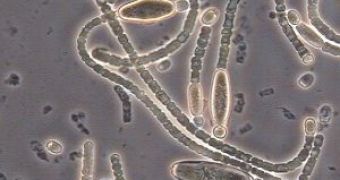Evidences have been unveiled that microorganisms lived on oxygen 2.72 billion years ago, 300 million years before the accumulation of oxygen in the Earth's atmosphere. This confirms the hypothesis that the adaptation to an atmosphere rich in oxygen was a long term process.
2.4 billion years ago, Earth's atmosphere was anaerobe (without oxygen). The first organisms to have evolved to photosynthesis are thought to be the cyanobacteria (blue-green bacteria) (photo).
Even the plants' chloroplasts are believed to be endosymbiotic cyanobacteria and they still possess their own DNA.
Through photosynthesis, the organisms produce sugar from water, carbon dioxide and light. The oxygen is a waste product of the process. When did photosynthesis appear, beginning to fuel the atmosphere with oxygen, is a matter of debate. "Our evidence points to the likelihood that Earth was peppered with small 'oases' of shallow-water, oxygen-producing, photosynthetic microbes around 2.7 billion years ago," stated Jennifer Eigenbrode of Carnegie's Geophysical Laboratory. "Over time these oases must have expanded, eventually enriching the atmosphere with oxygen. Our data record this transition."
Shifts in the fossil carbon isotopes in a 150 million-year interval recorded in shallow and deep-water sediments from the late Archean period (the Archean lasted from 3.8 to 2.5 billion years ago) in Western Australia, gave clues to the researchers. The proportions of carbon isotopes depend on the microbe's metabolism. Carbon is present in nature in the form of two isotopes, 12C and 13C, but, by far, the most abundant variety is the lighter, 12C, with 99 % abundance. "Photosynthetic microbes evolved in the shallow water where light was plentiful," explained Eigenbrode.
"They used light and CO2 to produce their food, like cyanobacteria do today. They gobbled up 12C and 13C, which became part of the organisms. The results are recorded in the rocks containing the remains for us to find billions of years later. Organisms leave behind different mixes of 12C and 13C depending on what they eat and how they metabolize it. Changes in these chemical fingerprints tell us about changes in how organisms got their energy and food."
The anaerobic microbes (those that lived without oxygen) ended up with relatively small amounts of 13C. The oxygen-based metabolism added an evolutionary advantage, as oxygen became more and more available in shallow ponds due to photosynthesis, and anaerobic microbes were eliminated by the aerobic ones. The aerobic organisms possessed increased 13C amounts, so the presence of 13C increased in the waters.
The increased 13C amount in the late Archean rocks indicates life was learning to cope with oxygen much earlier than the accumulation of important oxygen amounts.

 14 DAY TRIAL //
14 DAY TRIAL //